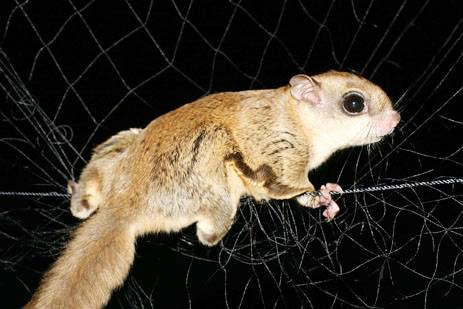 |
|||||||||||
|
|||||||||||
|
Glaucomys volans Photo Chris Burney © The flying squirrel is the only nocturnal member of the squirrel family in North America. Flying squirrels can sometimes be seen on bright moonlit nights as they glide from tree to tree, and they often reveal their presence by distinctive, high-pitched squeaks. Their large black eyes glow red in the light of a flashlight. Flying squirrels are only capable of gliding – not true flight. Their ability to glide comes from patagium, a loose flap of skin attached along the side of the body from ankle to wrist. When the squirrel launches its self from a tree, it extends its legs out to the side, stretching the patagium to produce a broad gliding surface. A cartilage in the wrist and muscles within the patagium strengthen the edges and control the shape of the patagium while the animal is gliding. The broad flat tail acts as a stabilizer and rudder. They can bank and execute 90-degree turns, as well as lateral loops. Most glides range from 18 to 50 feet but adults often make glides of up to 160 feet; the record is about 100 yards. The habit of gliding is thought to have evolved as an extension of long-distance leaping from branch to branch. These tiny squirrels forage mainly in the trees, feeding on nuts and seeds. They also eat insects, lichens, fungi, mushrooms, persimmons, wild grapes and tree bark. They appear to be a bit more carnivorous than other squirrels and will eat insects, bird eggs, nestlings and carrion. Like other squirrels they horde acorns in crevices. During cold weather flying squirrels do not hibernate but roost communally; two dozen or more will sometimes curl up together in a large tree cavity. They can reduce their metabolic rate and body temperature to conserve energy, and they benefit from one another's body heat.
Flying squirrels are found throughout Florida except in the Keys. They reach their highest densities in mature pine-oak woodlands and oak hammocks. They are also common in wooded urban parks and urban areas. In all habitats they need snags, or tree cavities for den sites. They will use birdhouses, or nest boxes, and sometimes move into attics. Major predators include owls, snakes, raccoons and domestic cats.
|
| • Live weather radar • About Florida weather • Map & Key to Regions |

Wildlife of Florida 2011
Fiona Sunquist
Download $19.99


Wildlife of Florida: Lizards
Fiona Sunquist
Download $2.49

gator/crocs | birds | mammals | snakes | turtles | frogs/toads | lizards | sharks
Wildlife | Favorite Activities | My Destinations | about us | resources | site map | home
![]() web site development by Creative Communications
web site development by Creative Communications












